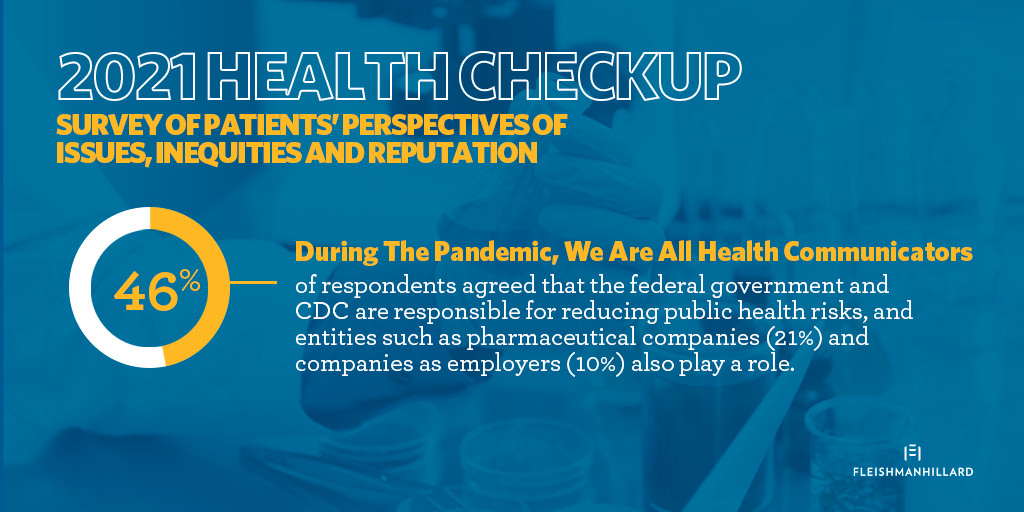During the Pandemic, We Are All Health Communicators
What that means for brands — and what research tells us about what works
With unparalleled high stakes and the need for urgent collective and individual action, the pandemic calls on each of us to support public health efforts. And with the fast-moving pace of information and misinformation alike, effective health communication is critical.
While political leaders and health experts have an assigned responsibility to provide accurate information and implement measures to respond to the pandemic, all of us — as individuals and as part of our respective organizations — have a role to play in improving the discourse and encouraging behaviors that can help save lives.
FleishmanHillard’s 2021 Health Checkup: Survey of Patients’ Perspectives of Issues, Inequities and Reputation (a survey fielded by TRUE Global Intelligence, the in-house research practice of FleishmanHillard, surveying 1,002 adults 18 years and older in the United States from December 15-28, 2020), found that people expect companies to share in the responsibility, alongside government, for solving some of our most pressing issues in 2021. For example, while 46% of respondents agreed that the federal government and the Centers for Disease Control and Prevention (CDC) are responsible for reducing public health risks, entities such as pharmaceutical companies (21%) and companies as employers (10%) — among others in the health care system — also play a role.
So what does this mean for brands – and how can health communications research inform our approach? Accurate and well-developed health communication can help individuals and communities better handle uncertainty and fear, promote and accomplish desired behavior change, and foster hope in the face of crisis.
With this in mind, the following are five key concepts to guide communications as informed by health research:
1. Lead with empathy. Fear is a natural response in the face of the pandemic. COVID-19 is scary for many reasons and there is much we still don’t know. Consequently, leaders face the difficult task of making people feel safe in the face of uncertainty. In these moments, information or policies that are too matter of fact be ignored – or worse.
Take care to be empathetic when asking people to take action or change how they do things. Acknowledge emotions and demonstrate concern for the impact of the situation for individuals and their lives.
2. Be transparent. Trust people with the information they need to make informed decisions and avoid the temptation to lean on vagueness or share only what is comforting or convenient. Clearly state what is known and unknown and acknowledge when facts are still evolving or likely to change. Take the time to explain not only what you’d like people to do, but why the actions are necessary. And when recommendations change, emphasize that they are based on new, previously unknown information.
3. Inspire action. A Danish political science researcher coined the term “optimistic anxiety,” which argues that “citizens must be anxious enough to take the advice from the authorities to heart and optimistic enough as to feel that their actions make a difference.” Even if individuals are more isolated than ever, appeals to the spirit of we-are-in-it-together can be critical to collective action.
For instance, in Norway, politicians appeal to the Norwegian tradition of “dugnad,” a word for joint action at a family or community level. Importantly, rather than just expressing a list of “don’ts,” aim to provide guidance for actions one can take and adopt easily into routines.
4. Think risk reduction, not elimination. Research shows that clear and simple messages may not change health behavior if they require an all-or-nothing approach. “Just say no” anti-drug campaigns and “abstinence-only” sex education are just two prominent examples. As it relates to the pandemic, overly restrictive policies may alienate those who might otherwise be inclined to follow the rules.
Alternatively, harm-reduction messaging looks for ways to reduce the risk of certain behaviors instead of asking people to avoid them altogether (e.g., encouraging masking and social distancing vs. demanding that people have no contact at all with friends or family they don’t live with). Research has found that this pragmatic, yet compassionate strategy helps people take control of their own choices and that, ultimately, they don’t take more risks than they would have otherwise.
5. Be mindful of privilege. Well-meaning health messages are ineffective if they are blind to the barriers that individuals may face taking desired actions (e.g., not being able to afford a prescribed medication, or not having access to nutritious food options). Privilege continues to play a significant role in the impact of COVID-19 on various populations — not only the toll of the disease itself, but the healthcare people receive, and the disparate impact of policies intended to control the pandemic.
For example, individuals who must continue to work in service jobs often have limited choices regarding what risk they will tolerate to take care of themselves and their families. Individuals who live alone or with depression may opt to socialize for their own mental health. And Black and Brown communities have experienced disparities in enforcement of social distancing guidelines.
While it’s important to protect populations at risk, individuals may come to different conclusions about what risk is tolerable to them. Effective health communications empower people to make informed choices and allow for individual needs and circumstances.
A pandemic of this scope and scale requires a broad, interdisciplinary response. Businesses and brands have the opportunity to be part of the solution by applying health behavior principles to communications with employees, customers and other key audiences.
